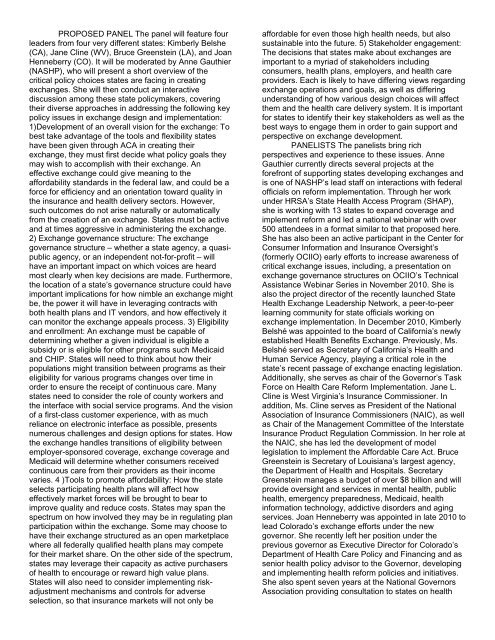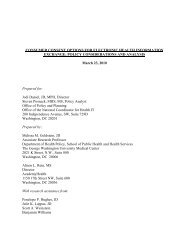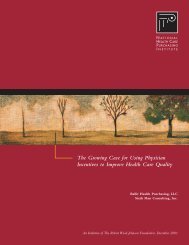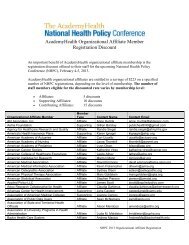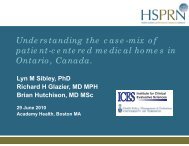Policy Roundtable Abstracts - AcademyHealth
Policy Roundtable Abstracts - AcademyHealth
Policy Roundtable Abstracts - AcademyHealth
Create successful ePaper yourself
Turn your PDF publications into a flip-book with our unique Google optimized e-Paper software.
PROPOSED PANEL The panel will feature four<br />
leaders from four very different states: Kimberly Belshe<br />
(CA), Jane Cline (WV), Bruce Greenstein (LA), and Joan<br />
Henneberry (CO). It will be moderated by Anne Gauthier<br />
(NASHP), who will present a short overview of the<br />
critical policy choices states are facing in creating<br />
exchanges. She will then conduct an interactive<br />
discussion among these state policymakers, covering<br />
their diverse approaches in addressing the following key<br />
policy issues in exchange design and implementation:<br />
1)Development of an overall vision for the exchange: To<br />
best take advantage of the tools and flexibility states<br />
have been given through ACA in creating their<br />
exchange, they must first decide what policy goals they<br />
may wish to accomplish with their exchange. An<br />
effective exchange could give meaning to the<br />
affordability standards in the federal law, and could be a<br />
force for efficiency and an orientation toward quality in<br />
the insurance and health delivery sectors. However,<br />
such outcomes do not arise naturally or automatically<br />
from the creation of an exchange. States must be active<br />
and at times aggressive in administering the exchange.<br />
2) Exchange governance structure: The exchange<br />
governance structure – whether a state agency, a quasipublic<br />
agency, or an independent not-for-profit – will<br />
have an important impact on which voices are heard<br />
most clearly when key decisions are made. Furthermore,<br />
the location of a state’s governance structure could have<br />
important implications for how nimble an exchange might<br />
be, the power it will have in leveraging contracts with<br />
both health plans and IT vendors, and how effectively it<br />
can monitor the exchange appeals process. 3) Eligibility<br />
and enrollment: An exchange must be capable of<br />
determining whether a given individual is eligible a<br />
subsidy or is eligible for other programs such Medicaid<br />
and CHIP. States will need to think about how their<br />
populations might transition between programs as their<br />
eligibility for various programs changes over time in<br />
order to ensure the receipt of continuous care. Many<br />
states need to consider the role of county workers and<br />
the interface with social service programs. And the vision<br />
of a first-class customer experience, with as much<br />
reliance on electronic interface as possible, presents<br />
numerous challenges and design options for states. How<br />
the exchange handles transitions of eligibility between<br />
employer-sponsored coverage, exchange coverage and<br />
Medicaid will determine whether consumers received<br />
continuous care from their providers as their income<br />
varies. 4 )Tools to promote affordability: How the state<br />
selects participating health plans will affect how<br />
effectively market forces will be brought to bear to<br />
improve quality and reduce costs. States may span the<br />
spectrum on how involved they may be in regulating plan<br />
participation within the exchange. Some may choose to<br />
have their exchange structured as an open marketplace<br />
where all federally qualified health plans may compete<br />
for their market share. On the other side of the spectrum,<br />
states may leverage their capacity as active purchasers<br />
of health to encourage or reward high value plans.<br />
States will also need to consider implementing riskadjustment<br />
mechanisms and controls for adverse<br />
selection, so that insurance markets will not only be<br />
affordable for even those high health needs, but also<br />
sustainable into the future. 5) Stakeholder engagement:<br />
The decisions that states make about exchanges are<br />
important to a myriad of stakeholders including<br />
consumers, health plans, employers, and health care<br />
providers. Each is likely to have differing views regarding<br />
exchange operations and goals, as well as differing<br />
understanding of how various design choices will affect<br />
them and the health care delivery system. It is important<br />
for states to identify their key stakeholders as well as the<br />
best ways to engage them in order to gain support and<br />
perspective on exchange development.<br />
PANELISTS The panelists bring rich<br />
perspectives and experience to these issues. Anne<br />
Gauthier currently directs several projects at the<br />
forefront of supporting states developing exchanges and<br />
is one of NASHP’s lead staff on interactions with federal<br />
officials on reform implementation. Through her work<br />
under HRSA’s State Health Access Program (SHAP),<br />
she is working with 13 states to expand coverage and<br />
implement reform and led a national webinar with over<br />
500 attendees in a format similar to that proposed here.<br />
She has also been an active participant in the Center for<br />
Consumer Information and Insurance Oversight’s<br />
(formerly OCIIO) early efforts to increase awareness of<br />
critical exchange issues, including, a presentation on<br />
exchange governance structures on OCIIO’s Technical<br />
Assistance Webinar Series in November 2010. She is<br />
also the project director of the recently launched State<br />
Health Exchange Leadership Network, a peer-to-peer<br />
learning community for state officials working on<br />
exchange implementation. In December 2010, Kimberly<br />
Belshé was appointed to the board of California’s newly<br />
established Health Benefits Exchange. Previously, Ms.<br />
Belshé served as Secretary of California’s Health and<br />
Human Service Agency, playing a critical role in the<br />
state’s recent passage of exchange enacting legislation.<br />
Additionally, she serves as chair of the Governor’s Task<br />
Force on Health Care Reform Implementation. Jane L.<br />
Cline is West Virginia’s Insurance Commissioner. In<br />
addition, Ms. Cline serves as President of the National<br />
Association of Insurance Commissioners (NAIC), as well<br />
as Chair of the Management Committee of the Interstate<br />
Insurance Product Regulation Commission. In her role at<br />
the NAIC, she has led the development of model<br />
legislation to implement the Affordable Care Act. Bruce<br />
Greenstein is Secretary of Louisiana’s largest agency,<br />
the Department of Health and Hospitals. Secretary<br />
Greenstein manages a budget of over $8 billion and will<br />
provide oversight and services in mental health, public<br />
health, emergency preparedness, Medicaid, health<br />
information technology, addictive disorders and aging<br />
services. Joan Henneberry was appointed in late 2010 to<br />
lead Colorado’s exchange efforts under the new<br />
governor. She recently left her position under the<br />
previous governor as Executive Director for Colorado’s<br />
Department of Health Care <strong>Policy</strong> and Financing and as<br />
senior health policy advisor to the Governor, developing<br />
and implementing health reform policies and initiatives.<br />
She also spent seven years at the National Governors<br />
Association providing consultation to states on health


